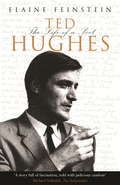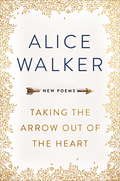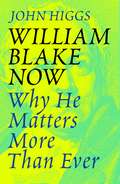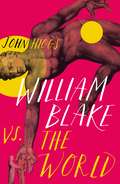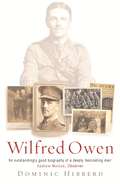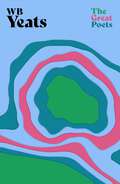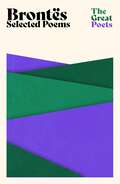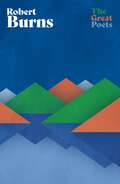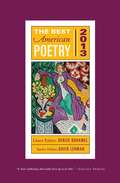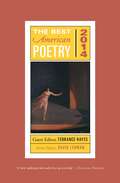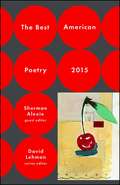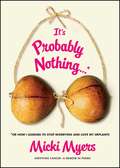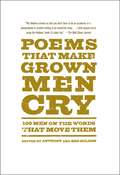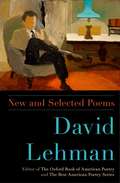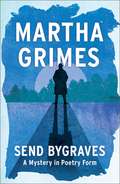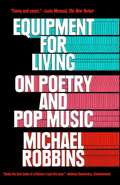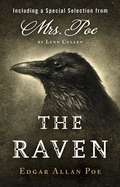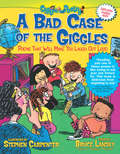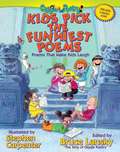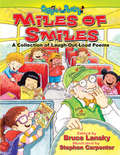- Table View
- List View
Ted Hughes: The Life of a Poet
by Elaine FeinsteinTed Hughes is one of the greatest English poets of this century, yet his life was dogged by tragedy and controversy. His marriage to the American poet Sylvia Plath marked his whole life and he never entirely recovered from her suicide in 1963, though he chose to remain silent on the subject for more than 30 years. Many people, including his friend Al Alvarez, have held Hughes's adultery responsible for Plath's death. Elaine Feinstein first met Hughes in 1969, and she was a good friend of his and his sister Olwyn's, both of whom guarded the Plath estate. She knows many of the European and America poets who so influenced Hughes - Seamus Heaney, Thom Gunn, Miroslav Holub, and knows the world in which both he and Plath moved.
Taking the Arrow out of the Heart
by Alice WalkerAlice Walker, author of the Pulitzer Prize-winning modern classic, The Color Purple, returns with a poetry collection that is both playfully imaginative and intensely moving. In Taking the Arrow Out of the Heart, Alice Walker examines our troubled times, while also chronicling a life well-lived. From poems of painful self-inquiry, to celebrating the simple beauty of everyday life, Walker offers us a window into her magical, at times difficult, and liberating world of activism, love, hope and, above all, gratitude. Whether she's urging us to preserve an urban paradise or behold exploring the necessity of beauty to the spirit, Walker demonstrates that she remains a revolutionary poet and an inspiration to generations of fans.
Taking the Arrow out of the Heart
by Alice WalkerAlice Walker, author of the Pulitzer Prize-winning modern classic, The Color Purple, returns with a poetry collection that is both playfully imaginative and intensely moving. In Taking the Arrow Out of the Heart, Alice Walker examines our troubled times, while also chronicling a life well-lived. From poems of painful self-inquiry, to celebrating the simple beauty of everyday life, Walker offers us a window into her magical, at times difficult, and liberating world of activism, love, hope and, above all, gratitude. Whether she's urging us to preserve an urban paradise or behold exploring the necessity of beauty to the spirit, Walker demonstrates that she remains a revolutionary poet and an inspiration to generations of fans.
William Blake Now: Why He Matters More Than Ever
by John Higgs'If a thing loves, it is infinite' William BlakeA short, impassioned argument for why the visionary artist William Blake is important in the twenty-first centuryThe visionary poet and painter William Blake is a constant presence throughout contemporary culture - from videogames to novels, from sporting events to political rallies and from horror films to designer fashion. Although he died nearly 200 years ago, something about his work continues to haunt the twenty-first century. What is it about Blake that has so endured? In this illuminating essay, John Higgs takes us on a whirlwind tour to prove that far from being the mere New Age counterculture figure that many assume him to be, Blake is now more relevant than ever.
William Blake vs the World
by John Higgs'A glittering stream of revelatory light . . . Fascinating' THE TIMES'Rich, complex and original' TOM HOLLAND'One of the best books on Blake I have ever read' DAVID KEENAN'Absolutely wonderful!' TERRY GILLIAM'An alchemical dream of a book' SALENA GODDEN'Tells us a great deal about all human imagination' ROBIN INCE***Poet, artist, visionary and author of the unofficial English national anthem 'Jerusalem', William Blake is an archetypal misunderstood genius. His life passed without recognition and he worked without reward, mocked, dismissed and misinterpreted. Yet from his ignoble end in a pauper's grave, Blake now occupies a unique position as an artist who unites and attracts people from all corners of society, and a rare inclusive symbol of English identity. Blake famously experienced visions, and it is these that shaped his attitude to politics, sex, religion, society and art. Thanks to the work of neuroscientists and psychologists, we are now in a better position to understand what was happening inside that remarkable mind, and gain a deeper appreciation of his brilliance. His timeless work, we will find, has never been more relevant.In William Blake vs the World we return to a world of riots, revolutions and radicals, discuss movements from the Levellers of the sixteenth century to the psychedelic counterculture of the 1960s, and explore the latest discoveries in neurobiology, quantum physics and comparative religion. Taking the reader on wild detours into unfamiliar territory, John Higgs places the bewildering eccentricities of a most singular artist into context. And although the journey begins with us trying to understand him, we will ultimately discover that it is Blake who helps us to understand ourselves.
Wilfred Owen: The definitive biography of the best-loved war poet
by Dominic HibberdThe definitive biography of the war poet - 'Dominic Hibberd has probably done more more than any other individual to illuminate Owen's life and work. His new Life is a triumph ... it is difficult to believe it will ever be superseded' Mark Bostridge, The Independent on SundayWhen Wilfred Owen died in 1918 aged 25, only five of his poems had been published. Yet he became one of the most popular poets of the 20th century. For decades his public image was controlled by family and friends, especially his brother Harold who was terrified anyone might think Wilfred was gay. In recent years much new material has become available. This book, based on over thirty years of wide-ranging research, brings new information to almost every part of Owen's life. Owen emerges as a complex, fascinating and often endearing character with an intense delight in being alive.
Wilfred Owen: The definitive biography of the best-loved war poet
by Dominic HibberdThe definitive biography of the war poet - 'Dominic Hibberd has probably done more more than any other individual to illuminate Owen's life and work. His new Life is a triumph ... it is difficult to believe it will ever be superseded' Mark Bostridge, The Independent on SundayWhen Wilfred Owen died in 1918 aged 25, only five of his poems had been published. Yet he became one of the most popular poets of the 20th century. For decades his public image was controlled by family and friends, especially his brother Harold who was terrified anyone might think Wilfred was gay. In recent years much new material has become available. This book, based on over thirty years of wide-ranging research, brings new information to almost every part of Owen's life. Owen emerges as a complex, fascinating and often endearing character with an intense delight in being alive.
W. B. Yeats: An inspiring collection from one of Ireland’s greatest literary figures (The Great Poets)
by W.B. Yeats'Tread softly because you tread on my dreams' is one of the most well-known and repeated lines of poetry ever written. Less haunting, but still so relevant: 'Life is a long preparation for something that never happens.'W B Yeats was one of the foremost figures of 20th century literature. Winner of a Nobel prize, he was also a political figure, and, as is evident from his earlier work, fascinated by Irish folklore and the occult. He was also deeply affected by the First World War and the Anglo-Irish and Irish civil wars. It is a testament to the greatness of Yeats' poetry that he attempts to bear witness to these emotional and historical forces.This perfectly pitched collection includes some of the greatest poetry of the 20th century.
W. B. Yeats: An inspiring collection from one of Ireland’s greatest literary figures (The Great Poets)
by W.B. Yeats'Tread softly because you tread on my dreams' is one of the most well-known and repeated lines of poetry ever written. Less haunting, but still so relevant: 'Life is a long preparation for something that never happens.'W B Yeats was one of the foremost figures of 20th century literature. Winner of a Nobel prize, he was also a political figure, and, as is evident from his earlier work, fascinated by Irish folklore and the occult. He was also deeply affected by the First World War and the Anglo-Irish and Irish civil wars. It is a testament to the greatness of Yeats' poetry that he attempts to bear witness to these emotional and historical forces.This perfectly pitched collection includes some of the greatest poetry of the 20th century.
Brontes: Selected Poems (The Great Poets)
by Anne Bronte Charlotte Bronte Emily BronteThe Bronte sisters lives and works have become modern-day cultural touchstones.Emily Bronte, best known for her novel WUTHERING HEIGHTS, began writing poetry first and, before her untimely death, wrote some of the most touching and emotive poems which often reflected the landscape of her Yorkshire home.Charlotte Bronte, whose novel JANE EYRE has had numerous TV and film adaptations, took responsibility for finding a home for their work. In her own words, ' We had very early cherished the dream of one day becoming authors'.Anne Bronte, author of AGNES GREY, often used autobiographical elements in her poems, giving us a hints of the struggles and turmoil of her life.These poems offer glimpses of the joys and sorrows of the Brontes and are a beautifully compelling introduction to their writing and lives.
Brontes: Selected Poems (The Great Poets)
by Anne Bronte Charlotte Bronte Emily BronteThe Bronte sisters lives and works have become modern-day cultural touchstones.Emily Bronte, best known for her novel WUTHERING HEIGHTS, began writing poetry first and, before her untimely death, wrote some of the most touching and emotive poems which often reflected the landscape of her Yorkshire home.Charlotte Bronte, whose novel JANE EYRE has had numerous TV and film adaptations, took responsibility for finding a home for their work. In her own words, ' We had very early cherished the dream of one day becoming authors'.Anne Bronte, author of AGNES GREY, often used autobiographical elements in her poems, giving us a hints of the struggles and turmoil of her life.These poems offer glimpses of the joys and sorrows of the Brontes and are a beautifully compelling introduction to their writing and lives.
Robert Burns: A superb collection from Scotland’s finest lyrical poet (The Great Poets)
by Robert Burns'Oh would some power the gift give us, to see ourselves as others see us!' Robert BurnsRobert Burns, poet and lyricist, also known as Rabbie Burns, is widely regarded as the National Poet of Scotland - and much of his work has become part of everyday modern language:'The best laid schemes o' mice and men...''To see her is to love her...'Often credited with writing the lyrics for Auld Lang Syne, he almost single-handedly inspired the movement that preserved Scottish music and lyrics which had been handed down the generations vocally for centuries, thereby maintaining Scots culture and language.A cultural icon and pioneer of the Romantic movement, Burns was chosen as the greatest Scot in a 2009 poll. This collection includes some of his best-loved, most beautiful work.'Now's the day, now's the hour' Robert Burns
Robert Burns: A superb collection from Scotland’s finest lyrical poet (The Great Poets)
by Robert Burns'Oh would some power the gift give us, to see ourselves as others see us!' Robert BurnsRobert Burns, poet and lyricist, also known as Rabbie Burns, is widely regarded as the National Poet of Scotland - and much of his work has become part of everyday modern language:'The best laid schemes o' mice and men...''To see her is to love her...'Often credited with writing the lyrics for Auld Lang Syne, he almost single-handedly inspired the movement that preserved Scottish music and lyrics which had been handed down the generations vocally for centuries, thereby maintaining Scots culture and language.A cultural icon and pioneer of the Romantic movement, Burns was chosen as the greatest Scot in a 2009 poll. This collection includes some of his best-loved, most beautiful work.'Now's the day, now's the hour' Robert Burns
The Best American Poetry 2013 (The Best American Poetry series)
by David LehmanBeloved and inventive poet Denise Duhamel selects the poems for the 2013 edition of The Best American Poetry, &“a &‘best&’ anthology that really lives up to its title&” (Chicago Tribune).Over the last twenty-five years, the Best American Poetry series has become an annual rite of autumn, eagerly awaited and hotly debated: &“an essential purchase&” (The Washington Post). This year, guest editor Denise Duhamel brings her wit and enthusiasm and her commitment to poetry in all its wide variety to bear on her choices for The Best American Poetry 2013. These acts of imagination—from known stars and exciting newcomers—testify to the vitality of an art form that continues to endure and flourish, defying dour predictions of its demise, in the digital age. This edition of the most important poetry anthology in the United States opens with David Lehman&’s incisive &“state of the art&” essay and Denise Duhamel&’s engagingly candid discussion of the seventy-five poems that made her final cut. Reflecting the vibrant state of our country&’s contemporary poetry scene, The Best American Poetry 2013 includes such eminences as John Ashbery, Louise Gluck, James Tate, and Richard Wilbur, as well as the fast-rising hot poets Sherman Alexie, Nin Andrews, Anna Maria Hong, Timothy Donnelly, Mary Ruefle, and Major Jackson.
The Best American Poetry 2014 (The Best American Poetry series)
by David Lehman Terrance HayesNational Book Award–winning poet Terrance Hayes selects the poems for the 2014 edition of The Best American Poetry, &“a &‘best&’ anthology that really lives up to its title&” (Chicago Tribune).The first book of poetry that Terrance Hayes ever bought was the 1990 edition of The Best American Poetry, edited by Jorie Graham. Hayes was then an undergrad at a small South Carolina college. He has since published four highly honored books of poetry, is a professor of poetry at the University of Pittsburgh, has appeared multiple times in the series, and is one of today&’s most decorated poets. His brazen, restless poems capture the diversity of American culture with singular artistry, grappling with facile assumptions about identity and the complex repercussions of race history in this country. Always eagerly anticipated, the 2014 volume of The Best American Poetry begins with David Lehman&’s &“state-of-the-art&” foreword followed by an inspired introduction from Terrance Hayes on his picks for the best American poems of the past year. Following the poems is the apparatus for which the series has won acclaim: notes from the poets about the writing of their poems.
The Best American Poetry 2015 (The Best American Poetry series)
by Sherman Alexie David LehmanThe premier anthology of contemporary American poetry continues with an exceptional volume edited by award-winning novelist and poet Sherman Alexie.Since its debut in 1988, The Best American Poetry has become a mainstay for the direction and spirit of American poetry. Each volume in the series presents the year's most extraordinary new poems and writers. Guest editor Sherman Alexie's picks for The Best American Poetry 2015 highlight the depth and breadth of the American experience. Culled from electronic and print journals, the poems showcase some of our leading luminaries--Amy Gerstler, Terrance Hayes, Ron Padgett, Jane Hirshfield--and introduce a number of outstanding younger poets taking their place in the limelight. A leading figure since his breakout poetry collection The Business of Fancydancing in 1992, Sherman Alexie won the National Book Award for his novel The Absolutely True Diary of a Part-Time Indian. He describes himself as "lucky enough to be a full-time writer" and has written short stories, novels, screenplays, and essays--but he is at his core a poet. As always, series editor David Lehman's foreword assessing the state of the art kicks off the book, followed by an introductory essay in which Alexie discusses his selections. The Best American Poetry 2015 is a guide to who's who and what's happening in American poetry today.
It's Probably Nothing...*
by Micki MyersDaring, sly, and unlike any other book you've read, this memoir-in-poems tackles cancer with a bawdy wit guaranteed to make you laugh your wig off.As a vibrant woman in her early forties, mother of two, poet, artist, and teacher, Micki Myers decided to confront her cancer diagnosis head on with the sharpest tools in her arsenal: namely, her sense of humor and unbridled poetic license. The result is a charming, poignant, laugh-out-loud collection that hits all the highs (morphine) and lows (everything else) of being a cancer patient and surviving with your spirit intact (even if your boobs are not). It's Probably Nothing... is the perfect gift for a friend in crisis, providing laughter, wisdom, and much-needed perspective. From losing your hair (even, ahem, down there) and gaining two bouncy silicone strangers, to the pitfalls of marijuana therapy and the endless chemo-room muzak "that makes you think/survival might be overrrated," Myers reminds you that you're not alone and that it's okay to laugh.
Poems That Make Grown Men Cry: 100 Men on the Words That Move Them
by Anthony Holden Ben HoldenGrown men don't cry. But in this fascinating anthology, one hundred men--distinguished in literature and film, science and architecture, theater and human rights--confess to being moved to tears by poems that continue to haunt them. Representing twenty nationalities and ranging in age from their early 20s to their late 80s, the majority are public figures not prone to crying. Here they admit to breaking down when ambushed by great art, often in words as powerful as the poems themselves. Their selections include classics by visionaries such as Walt Whitman, W.H Auden, and Philip Larkin, as well as contemporary works by masters including Billy Collins, Seamus Heaney, Derek Walcott, and poets who span the globe from Pablo Neruda to Rabindranath Tagore. Seventy-five percent of the selected poems were written in the twentieth century, with more than a dozen by women including Mary Oliver, Elizabeth Bishop, and Gwendolyn Brooks. Their themes range from love in its many guises, through mortality and loss, to the beauty and variety of nature. Three men have suffered the pain of losing a child; others are moved to tears by the exquisite way a poet captures, in Alexander Pope's famous phrase, "what oft was thought, but ne'er so well express'd. From J. J. Abrams to John le Carré, Salman Rushdie to Jonathan Franzen, Daniel Radcliffe to Nick Cave, Billy Collins to Stephen Fry, Stanley Tucci to Colin Firth, and Seamus Heaney to Christopher Hitchens, this collection delivers private insight into the souls of men whose writing, acting, and thinking are admired around the world.
New and Selected Poems
by David LehmanA major collection of poems from one of our most accomplished poets, the prominent man of letters behind The Best American Poetry series.Drawing from a wealth of material produced over the course of more than forty years, David Lehman's New and Selected Poems displays the remarkable range of his poetic genius. From the beginning Lehman has combined the traditional with the experimental, intellect with passion, creating a singular body of work in a manner all his own. Beginning with a selection of compelling new poems that feature the poet's customary wit and ingenuity and add a layer of surprise and suspense, the book follows with carefully selected pieces from Lehman's seven full-length books of poetry since 1986: Yeshiva Boys (2009), When a Woman Loves a Man (2005), The Evening Sun (2002), The Daily Mirror: A Journal in Poetry (2000), Valentine Place (1996), Operation Memory (1990), and An Alternative to Speech (1986). A group of uncollected works, including hard-to find early poems from the late 1960s and 1970s, rounds out the volume. These are poems that captivate as they stimulate thought, poems that capture the romance, irony, and pathos of love, and poems that are lyrical and lovely in unexpected, sometimes even comic ways. A master of his craft, Lehman is as fluent in the prose poem as in the sonnet, the sestina, the villanelle, and verse forms of his own invention. He departs from autobiography not only in fictional forays but in poems that ponder the lives of World Historical Individuals (Napoleon, Wittgenstein, Freud), the persistence of ancient myths in modern life, the mysteries of love and desire, and his own heritage as the son of Holocaust refugees. Lehman's poems are dazzling in their evocation of the recent past. As Mary Jo Bang has written, "the whole of a world is here, and the remnants of an era--from Dinah Shore to Bob Dylan, from Hitler to Nixon." This is as inspiring and thought-provoking and beautiful a book as any David Lehman has written.
Send Bygraves
by Martha GrimesIn Send Bygraves, Martha Grimes has given us her most fascinating book, a dramatic mystery poem that uses the conventions of the traditional British mystery to explore the very nature of crime, the criminal, and the criminal investigator. Illustrated with thirty-five line drawings by acclaimed artist Devis Grebu, it is an elegant, darkly humorous work--a tour de force of chilling wit and brilliant literary imagination.
Equipment for Living: On Poetry and Pop Music
by Michael RobbinsBrilliant, illuminating criticism from a superstar poet—a refreshing, insightful look at how works of art, specifically poetry and popular music, can serve as essential tools for living.How can art help us make sense—or nonsense—of the world? If wrong life cannot be lived rightly, as Theodor Adorno had it, what weapons and strategies for living wrongly can art provide? With the same intelligence that animates his poetry, Michael Robbins addresses this weighty question while contemplating the idea of how strange it is that we need art at all. Ranging from Prince to Def Leppard, Lucille Clifton to Frederick Seidel, Robbins’s mastery of poetry and popular music shines in Equipment for Living. He has a singular ability to illustrate points with seemingly disparate examples (Friedrich Kittler and Taylor Swift, to W.B. Yeats and Anna Kendrick’s “Cups”). Robbins weaves a discussion on poet Juliana Spahr with the different subsets of Scandinavian black metal, illuminating subjects in ways that few scholars can achieve. Equipment for Living is also a wonderful guide to essential poetry and popular music.
The Raven: With The Philosophy Of Composition (Lezama Ser.)
by Edgar Allan PoeVisions in Poetry is an exciting and unique series of classic poems illustrated by outstanding contemporary artists in stunning hardcover editions. The fifth book in the series, Edgar Allan Poe's "The Raven," delves into the hidden horrors of the human psyche. Originally published in 1845, the poem is narrated by a melancholy scholar brooding over Lenore, a woman he loved who is now lost to him. One bleak December at midnight, a raven with fiery eyes visits the scholar and perches above his chamber door. Struggling to understand the meaning of the word his winged visitant repeats - "Nevermore!" - the narrator descends by stages into madness. Illustrator Ryan Price's exquisitely grim illustrations suggest a background story shaped by the narrator's guilt, embodied in the terrifying figure of the raven. Price's drypoint technique, with its rich blacks and feathery lines, perfectly captures the nightmarish atmosphere of this unforgettable poem.
A Bad Case of the Giggles: Poems That Will Make You Laugh Out Loud (Giggle Poetry)
by Bruce Lansky Stephen CarpenterThe Giggles Are Gonna Get You!Bolt the doors and get out of earshot when kids discover A Bad Case of the Giggles. One of the funniest collections of children's poetry, this book includes creations from some of the most entertaining children's poets, including Kenn Nesbitt, Bruce Lansky, Eric Ode, Bill Dodds, Joyce Armor, Linda Knaus, Eileen Spinelli, Robert Scotellaro, Rebecca Kai Dotlich and more.
Kids Pick The Funniest Poems: Poems That Make Kids Laugh (Giggle Poetry)
by Bruce Lansky Stephen CarpenterBetcha laugh!This is one of the most popular collections of funny poetry for kids ever published. It's a classic because it's the first collection of poems selected by kids! It includes clever creations from some of the most popular names in children's poetry, including Bill Dodds, Timothy Tocher, Joyce Armor, Robert Pottle, Bruce Lansky, and Kenn Nesbitt. Humorous illustrations by Stephen Carpenter make this book even better.
Miles of Smiles: A Collection of Laugh-Out-Loud Poems (Giggle Poetry)
by Bruce Lansky Stephen CarpenterYou'll Find a Smile on Every Page of this Book!Thousands of elementary-school students helped Bruce Lansky, "The King of Giggle Poetry," pick the poems by Kenn Nesbitt, Joyce Armor, Joan Horton, Eric Ode, Dave Crawley, Ted Scheu, and other poets included in this book. If these poems don't put a smile on your face, Stephen Carpenter's hilarious illustrations surely will!
